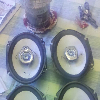V8BoatBuilder
Transplanted Bostonian
- Joined
- November 4, 2002
- Messages
- 3,411
- Reaction score
- 8
- City, State
- East Brunswick, NJ
- Year, Model & Trim Level
- 97 Mountaineer V8 4x4
I heard some scuttlebutt from a few people, and wanted to confrim myth or truth:
1) The shoes can be installed "backwards." All 4 looked identical, with only a top and bottom..
2) Shoes need to be broken-in for max holding power, but say taking the vehicle up to 30mph and pushing on the pedal slowly till the vehicle stops.
1) The shoes can be installed "backwards." All 4 looked identical, with only a top and bottom..
2) Shoes need to be broken-in for max holding power, but say taking the vehicle up to 30mph and pushing on the pedal slowly till the vehicle stops.

 I just hate busting my @$$ trying to fix something for several weeks only to bring it to a shop and have them fix it quickly..
I just hate busting my @$$ trying to fix something for several weeks only to bring it to a shop and have them fix it quickly..










